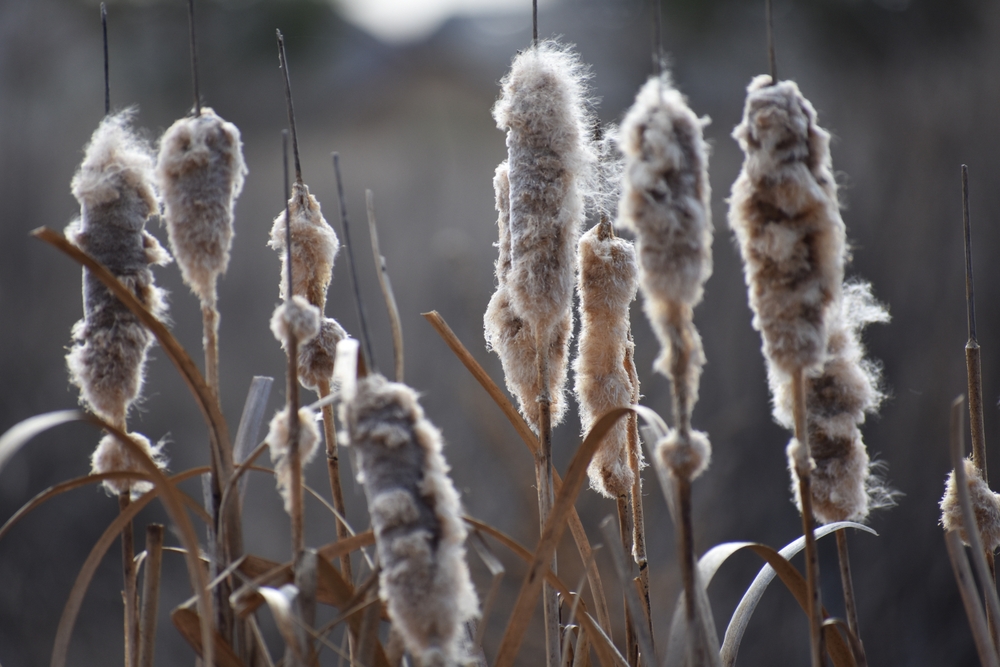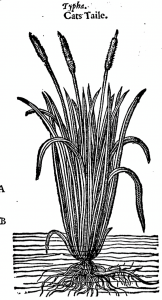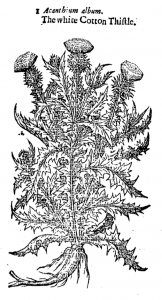
Bedding ‘Down’ in Early Modern England
In the next instalment of our mini-series ‘Materials of Sleep’, Dr Holly Fletcher explores the role of plant ‘down’ in the bedding materials of early modern England and early America.
Beds, mattresses, pillows and quilts were filled with a variety of stuffing materials in the early modern period. In addition to better-known materials such as feathers, woollen flocks or straw, such items could be filled with plant ‘down’. This consisted of the fluffy seed heads of plants such as the thistle or cattail (Typha, known in British English as bulrush) which resemble the soft, feathery down of birds.
A cattail stem is estimated to have 200,000 ‘nutlets’ or seeds, which each bear a tuft of fluffy whitish hairs, allowing the seeds to be dispersed in the wind. This fluff has been put to many uses, including as tinder for lighting fires, as a form of insulation and even as a buoyancy aid in WWII life jackets. Its use for stuffing cushions and bedding materials has been widespread.[1] A small pillow filled with cattail floss was discovered by archaeologists in a Peruvian excavation in 1932, for instance, while one name for the cattail in the Algonquian Potawatomi language is ‘bewiieskwinuk’ ‘we wrap the baby in it’, making reference to its use for the bedding of infants by the Potawatomi people.[2]
The down of the cattail plant was also recognised as a useful bedding material in early modern England. John Gerard included cattails in his Herball or Generall Historie of Plantes, first published in 1597. He wrote of the seed head of cattails as ‘soft, thicke and smooth, seeming to be nothing else but a deale of flockes thicke set and thrust together, which being ripe turneth into a downe and is carried away with the winde’. On ‘the vertues’ of this material, he stated ‘this downe in some places of the Isle of Elie, and the low countries adjoining thereto, is gathered and well sold to make mattresses of, for plowmen and poore people’.

Cats Taile in John Gerard, The herbal or general history of plants (London, 1633).
The cattail plant itself was frequently referred to as ‘dunce down’ in English which, early modern botanists explained, was because the down could make a person deaf if it entered their ears.[3] It seems likely, however, that this name also originated from the similarity of such down to feather down, meaning it was ‘fool’s down’ in the same sense that cheaper metals could be referred to as ‘fool’s gold’.[4] This similarity also ensured that it could be used to deceive, or fool, those who bought plant down bedding mistaking it for feather down.
This deceit was recognised by Gerard in his comments on thistle down, as he wrote of the ‘Cotton-Thistle’: ‘The common thistle whereof the greatest quantitie of down is gathered for divers purposes, as well by the poore to stop pillowes, cushions, and beds for want of feathers, as also bought of the rich Upholsters to mixe with the feathers and downe they do sell’, and this latter practice he described as a ‘deceit’.

The White Cotton Thistle in John Gerard The herbal or general history of plants (London, 1633).
According to Gerard, therefore, bedding made of plant down could serve two purposes. Firstly it could be a cheap alternative to other forms of stuffing for poorer people, and secondly it could be mixed in with feathers by upholsterers seeking to cut costs and increase their profit margins, thus deceiving their customers.
In June 1594, these two potential uses for plant down became key points of debate in a dispute about the use of plant down by London upholsterers. Since 1499 an act had been in place which forbade the sale of bedding made of ‘corrupte stuffes’, which it stated was ‘contagious for mannys body to lye on’. Among such ‘stuffes’ was listed ‘fen downe’, a term used to refer to cattail down collected on fenland, as Gerard described for the Isle of Ely. When the act was reissued in 1552 both fen down and thistle down were listed as ‘unlawful’ for use in bedding. Significantly these regulations, which remained in force throughout the sixteenth and seventeenth centuries, only applied to those beds which would be sold rather than those which were made for personal use.
From 1585 onwards, however, concerns were raised that upholsterers were continuing to use unlawful materials in their beds and bedding, and in 1594 members of the Worshipful Company of Upholders in London petitioned William Cecil, chief advisor to Queen Elizabeth I, to defend their practices. About fen down, they wrote, ‘in some cases we find it tolerable, that is for stuffing of cushions and making of bedding for the poore whose abilitie may not reach hyer’. They also responded to complaints that the material was unhealthy for people’s bodies and could result in putrefaction, stating:
‘we know that the stuffe it selfe will breed nothing that is hurtfull to the health of the bodie. Onelie in the first yeare it is gathered it will breed a worme while it is greene but being a yeare old the stuff is as sweet and cleane as any fether and for this order is taken by us that none shall be used until it be a yeare old as also by the parties that gather them which is the poore people in the Yle of Elye’.
The upholsterers thus indicated material knowledge of this plant down which needed to be dried for over a year before it could be a healthful stuffing for beds. They also suggest that this knowledge was shared by the people in Ely who collected the down, both for their own use and to sell to upholsterers. This collection would have taken place between July and August each year, when Gerard stated ‘they floure and beare their mace’. Furthermore, the upholsterers denied any knowledge of the material’s use in deceiving customers who believed they were purchasing a feather bed, as they stated ‘the mingling of this stuffe with fethers or any other stuff to deceive is a thing which we never heard of or knew’.
This petition was challenged by a separate group of London upholsterers, who appealed to Burghley in July 1594. They confuted their fellow upholsterers’ arguments, stating:
‘fen downe is not tolerable in anye thinge. If it be putt in Cusshions or any kinde of bedding before it be 2 yere ould it turns altogeather to wormes and maggots. If it be putt in cushions etc after it is twoe yere ould it turns all to dust and dross and it is to be throwne out to the Dungehill. If it be used in flocke beds it filleth mens bodies with most filthie diseases’.
Their plea for official searches of bedding being sold in the city of London was not immediately answered. After 1626, however, the Company of Upholders received the royal charter and was granted the powers of search. The royal charter itself explicitly banned the use of fen down and thistledown. While the Company’s records were destroyed in the Great Fire of London in 1666, subsequent court minute books reveal that searches did take place and that sellers of beds and bedding containing plant down were fined and their wares were confiscated. In March 1690, for example, John Gatehouse of Fleetditch was fined for having an old bed filled with a mixture of thistledown and feathers, while in 1700 Alexander Rumperth from the West End was fined for having a sea bed filled with thistle down and flocks. Interestingly, fen down does not appear in any of these records, and it is tempting to view this as a result of the wide-scale drainage projects that greatly impacted on the plant-life in the fenlands from the seventeenth century onwards.[5]
Plant down was a source of controversy among upholsterers, yet it was also a staple bedding material among poorer communities in rural England whose environmental expertise enabled them to harvest and prepare it for use in stuffing pillows and beds. This preparation was tied to questions surrounding the healthfulness of such down, as concerns about bodily integrity pervaded discussions about bedding materials. Uncovering the use of plant down in bedding thus offers new insights into the material sleeping conditions of early modern people, particularly those who could not afford better-known bed-fillings such as feathers and flocks.
[1] Julia F. Morton, ‘Cattails (Typha spp.): Weed Problem or Potential Crop?’, Economic Botany, 29 (1975), pp. 7-29.
[2] E. Yacovleff & F. L Herrero, El Mundo Vegetal de los Antiguos Peruanos, (Lima: Museo Nacional, 1932), pp. 243-322, cited in Morton, ‘Cattails’; Rob Wall Kimmerer, Braiding Sweetgrass: Indigenous Wisdom, Scientific Knowledge and the Teachings of Plants, (Uxbridge: Penguin Random House, 2020), p. 230.
[3] In this case, deafness was equated to foolishness. You can read more on early modern experiences and understandings of deafness in Emily Cockayne, ‘Experiences of the Deaf in Early Modern England’, The Historical Journal, 46 (2003), pp. 493-510.
[4] Though today ‘fool’s gold’ refers specifically to the mineral pyrite, this was not the case until the nineteenth century. See David Richard, Pyrite: A Natural History of Fool’s Gold, (Oxford: Oxford University Press, 2015), pp. 6-10.
[5] See Eric Ash, The Draining of the Fens: Projectors, Popular Politics, and State Building in Early Modern England (Baltimore: Johns Hopkins University Press, 2017).








0 Comments